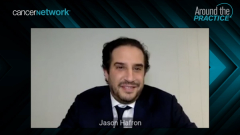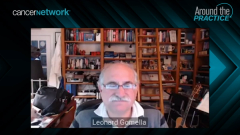
Patient Case #1: Treatment Selection in mCNPC
Dr Raoul S. Concepcion presents the case of a 69-year-old man with metastatic castration-naïve prostate cancer (mCNPC), and the panel shares their personal approaches to treatment.
Episodes in this series

Raoul S. Concepcion, MD, FACS: Let’s go to the first case. This is module 1, and we’re going to talk about recent advances in the treatment of metastatic castration-naïve prostate cancer. We’ve generally gone to this type of nomenclature. We should have some standardization. Everybody is very comfortable with castration-resistant prostate cancer. Many of us have used castration sensitive and hormone sensitive. I changed this because I was looking at the 2022 NCCN [National Comprehensive Cancer Network] Guidelines, and they changed their nomenclature to castration naïve.
In this case, we have a 69-year-old, white man who presents to the emergency department with progressive fatigue, low back pain, decreased appetite, weight loss, and an abnormal DRE [digital rectal exam] showing a bilateral induration and urinary retention. Fully captured and replaced. He was referred to urology for evaluation. In the urology office his prostate-specific antigen level was 144 ng/mL. He underwent biopsy and showed a Gleason grade group 3, which is 3+4 in 8 of 12 cores. Conventional imaging reveals both nodal and a single bony metastatic lesion into the pelvis. His ECOG performance status is 1.
For the audience, before we get into the discussion, what would your treatment of choice be for this patient? This is a de novo, newly diagnosed metastatic castration-naïve prostate cancer. What would you recommend: A) docetaxel plus ADT [androgen deprivation therapy], B) abiraterone plus ADT, C) enzalutamide plus ADT, D) apalutamide plus ADT, or—just for grins—E) ADT only. I’d like to see how this is answered.
Jason, as we’re talking about this—and this is a fairly common presentation that you see— what’s your thought process?
Jason M. Hafron, MD, CMO: For neurologists, it’s critical that we use it differently from how we have before. Metastatic disease is a wide spectrum. Historically we would look at a patient’s metastatic disease and put them on androgen deprivation therapy. But there are a lot of nuances with metastatic disease, especially in castration sensitive. Specifically, what’s the timing of the metastatic disease? Is it de novo? Is it metachronous? Is it a failure of a primary therapy? Most important, what’s the number of metastatic lesions in the bone? When you look at these patients, you have to understand that all metastatic disease is not the same. There are small nuances, whether they’re high volume for bone lesions outside the spinal column or the pelvis, or visceral metastases, or low volume if there are fewer than 4 lesions. On top of that, where is the metastatic disease? Is it bone, lymph, or visceral? Once you understand the nuances, you’ll better understand the literature. Then once you understand that and relate to the literature, you can apply a lot of the newer therapies and combination therapies that are available.
Raoul S. Concepcion, MD, FACS: Oliver, anything to add to Jason’s commentary?
Oliver Sartor, MD: Yes. A couple of things. This will be a low-volume metastatic disease by the CHAARTED criteria. It’s interesting: if you look at de novo patients, there may be some additional benefit from docetaxel, but it’s probably more problematic than 1 of the hormonal therapies. The data with abiraterone, enzalutamide, and apalutamide may be better here.
A couple of other things that I’ll add. No. 1, we want to get germline genetics on this guy because that’s part of the NCCN Guidelines. No. 2, with a single focus of bone metastatic disease, I may want to know if there’s more to this story. I may get a PSMA [prostate-specific membrane antigen] PET [positron emission tomography] scan on this guy, if I can get it, to define whether he’s oligometastatic. He’s got a PSA [prostate-specific antigen] of 144 ng/mL, but it’s high, so I might want a PSMA PET. If we look at the STAMPEDE data on a low-volume patient like this, it should radiate the prostate and have level 1 evidence to demonstrate that radiation to the prostate can prolong survival. To be honest, I’d consider metastasis-directed therapy, even though that’s more controversial. In my practice, I try to do germline genetics. I don’t necessarily need any somatic genetics right now. I’ve got a PSMA PET scan. I’d plan on radiation to the prostate. I’d be using ADT plus a novel hormone, and I’d consider the possibility of metastasis-directed radiation. That’s what I would do. I may be a little out there. Let me hear from others because sometimes I get a little exuberant about new data.
Raoul S. Concepcion, MD, FACS: Lenny, let’s pump this to you because you and I grew up in the era when if it was metastatic, we didn’t do anything with the primary. We just chopped it up to metastatic disease, and we didn’t aggressively manage the primary. We all lived through the disasters of people once they blow through hormonal therapy, and we wish that we would have at least taken out the prostate to control local disease. Dovetailing on what Oliver said, relative to your first thoughts, I want you to tell them, from a urological perspective, your thoughts in managing the primary.
Leonard G. Gomella, MD, FACS: As Oliver and Jason laid out, you have a whole host of level 1 evidence to treat this patient. You have everything from straight ADT through docetaxel plus ADT, plus ADT plus all the novel androgen receptor pathway blockers. Then you compound that with Oliver’s point about treating the primary and then consider treating the oligometastatic lesion. One of the things we must remember, because this is a low-volume patient and docetaxel may not be his best option, is that docetaxel is limited in a course of infusion. Very often there’s financial toxicity with a lot of the oral agents. The data would say docetaxel plus ADT is not a top-line therapy, but the subtleties that Jason mentioned for individual patients are that this may be a man who has no resources for $8000 to $10,000 a month for those other agents. The data say for low-volume metastatic disease ADT plus docetaxel may not be necessary, but there may be personal and individual considerations. That may be the quickest, easiest, most efficient, and least financially toxic way to treat this man. But apalutamide, enzalutamide, and all the oral agents are open to this gentleman with basic ADT.
Raoul S. Concepcion, MD, FACS: The point that you’re stressing is that the standard of care is ADT plus some agent for intensification of therapy. The days of ADT alone, especially in a de novo metastatic castration-naïve patient, are—dare I say—passé.
Transcript Edited for Clarity
Newsletter
Stay current with the latest urology news and practice-changing insights — sign up now for the essential updates every urologist needs.
























